Bjqthy Insights
Exploring diverse topics and the latest trends.
React Development: Where Code Meets Creativity
Unlock your creativity with React development! Discover tips, tricks, and insights to elevate your coding game today!
Top 10 Creative React Components to Enhance Your Web Development Skills
Web development has evolved significantly, and React components have become a cornerstone of creating dynamic user interfaces. In this article, we will explore the Top 10 Creative React Components that can not only enhance your projects but also elevate your development skills. By incorporating these innovative components into your workflow, you can streamline your coding process and create more engaging applications.
- React Router: Essential for navigating between pages in your application.
- Material-UI: A popular UI framework that offers pre-built components that follow Google's Material Design.
- React Spring: A flexible library for adding physics-based animations to your components.
- Styled Components: Enables you to write CSS directly in your JavaScript with ease.
- Formik: Simplifies handling forms and validation in your React applications.
- React Hook Form: A performant way to manage forms using hooks.
- D3.js: Combine with React for powerful data visualization capabilities.
- React Query: A data-fetching library that manages your server state efficiently.
- Recharts: A composable charting library built on React components.
- React Helmet: Manage your document head and improve your app's SEO.

How to Use React Hooks for More Dynamic User Interfaces
React Hooks have revolutionized the way developers create dynamic user interfaces by enabling state and lifecycle management without the need for class components. One of the most popular hooks, useState, allows you to manage state in functional components, making it easier to create interactive elements. For instance, you can implement a simple counter component like this:
- Import the
useStatehook from React. - Initialize state to hold your counter value.
- Create functions to increment and decrement the count.
This approach streamlines your code and enhances readability, allowing you to focus on building a more engaging user experience.
Another vital hook is useEffect, which allows you to perform side effects in your components, such as fetching data from an API or updating the DOM. By leveraging useEffect, you can handle these side effects with great control and precision. For example:
useEffect(() => { fetchData(); }, []);
This code snippet fetches data when the component mounts, ensuring that your UI stays dynamic and responsive to user interactions. By mastering these hooks, you can create more complex and dynamic user interfaces that provide a seamless experience for your users.
What Makes React the Go-To Library for Modern Web Development?
React has emerged as the go-to library for modern web development due to its component-based architecture, which promotes reusability and maintainability. By breaking down the user interface into small, isolated components, developers can build complex applications more efficiently. This modularity not only allows for easier debugging but also enhances collaboration among team members, as different developers can work on separate components simultaneously. Additionally, React's virtual DOM improves performance by minimizing direct manipulations in the actual DOM, leading to faster updates and a smoother user experience.
Another reason for React's popularity is its strong community support and extensive ecosystem. With numerous third-party libraries and tools available, developers have a wealth of resources at their disposal. The ability to integrate with other technologies, such as Redux for state management or Next.js for server-side rendering, further solidifies React's role in modern web development. Moreover, continuous updates from Facebook ensure that React remains up-to-date with the latest trends and best practices, making it a reliable choice for both new projects and ongoing developments.